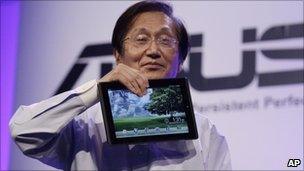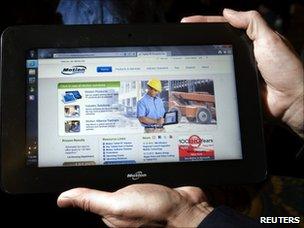CES gadget show dominated by tablet computers
- Published
A look at three useful gadgets at CES
Tablets look set to hog the headlines at this year's Consumer Electronics Show in Las Vegas.
Industry watchers expect 100 or more of the portable gadgets to be shown off at the four-day technology extravaganza.
About 120,000 people are expected to visit the 150,000 sq m (1.6m sq ft) of exhibition halls the show fills.
The devices are part of a trend towards greater mobility and smarter living that are starting to define some parts of the market in 2011.
Early estimates suggested only about 80 tablets would be on the stands at CES in 2011, said Shawn Dubravac, chief economist and director of research at the Consumer Electronics Association (CEA) prior to the show opening.
"I would not be surprised to see 100 plus tablets at CES this year," he said.
Flat future
One of the first companies to unveil its range of tablet devices at the show was Taiwan's Asus, a company credited with kick-starting the netbook market with its Eee machine.
The company showed off four devices including the Eee Pad Transformer, which looks like a laptop but can split into two to allow the screen to function as a tablet.
Its machines run a combination of Google's Android operating system and Microsoft's Windows 7.
Asus chairman Jonney Shih credited Apple for kick-starting the tablet market with its iPad, as he unveiled the gadgets.

The Asus Transformer splits into two devices
"We admire companies like Apple that offer great innovation, but they provide very limited choices for the customers," he said. "Different kinds of customers have different kinds of needs, and the best way to better serve them is to provide choice."
He also demonstrated the Eee Pad Slider, a tablet with a keyboard that slides out of its left side and its touchscreen Slate device.
Other companies including Lenovo and Motion Computing showed off Windows-based tablets. Lenovo also demonstrated a hybrid device that combined a 10-inch Android-powered tablet with a Windows-powered laptop base.
The device is currently only available in China.
Mr Dubravac said that not all the gadgets being shown would make it to the shop shelves, as both consumers and manufacturers were still finding out what they wanted to do with the devices.
"There's going to be a lot of competition and experimentation in this spectrum," he said.
While many of the tablets would be general computing devices, said Mr Dubravac, many would have very narrowly defined uses as manufacturers seek to set their tablet apart from the competition.
For instance, he said, it was likely that Research In Motion would target its Playbook at businesses and board rooms rather than consumers in the home.
'Dumb devices'
Although consumers were still finding out what they wanted to do with tablets, said Mr Dubravac, it was not clear that their appearance in large numbers was slowing down sales of a similar gadget with a very defined use: e-book readers.

Some firms are using Windows software to power tablets
This was because, he said, e-book readers tended to be cheaper than most tablets largely because the makers of the devices were tending to sell them initially at a loss because they knew they could make up the difference through sales of e-books.
The CEA expects, said Mr Dubravac, that between them, e-book readers and tablets should sell about 50 million units in 2011. He questioned estimates that suggested sales could be much higher because there was not enough manufacturing capacity or demand to sustain any larger market at the moment.
While manufacturers and consumers were feeling their way with tablets, CEA research suggests that maturing use of other devices will drive demand in the consumer electronics market.
For instance, Mr Dubravac said, smartphones were becoming the nexus through which previously dumb devices were acquiring intelligence. Body monitors were piping data they collect during exercise through a phone to help people get the most out of a work-out.
The useful data can only be collected because of another key consumer electronics trend, said Mr Dubravac which was the availability of small, cheap sensors such as accelerometers and gyroscopes. Widely used in smartphones they were also starting to show up in other gadgets such as digital cameras or goggles worn by skiers and snowboarders.
The final trend defining consumer electronics in 2011 and beyond would be the growing "applification" of products which seek to make products easier to use and interrogate through the use of small self-contained programs, or applications.
These trends, said Mr Dubravac, were shifting the focus of the consumer electronics industry.
"There's never been more demand for portable products," he said.
CES runs from 6 to 9 January in Las Vegas.